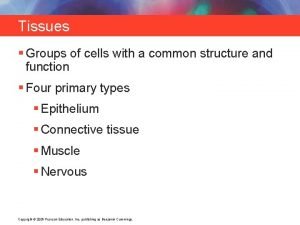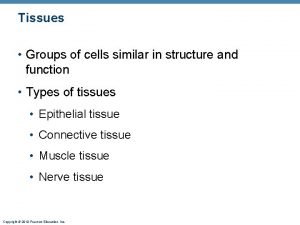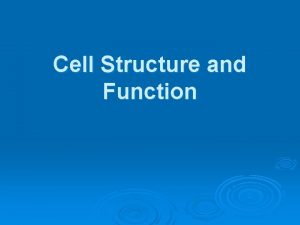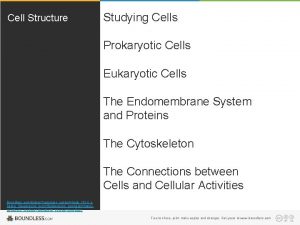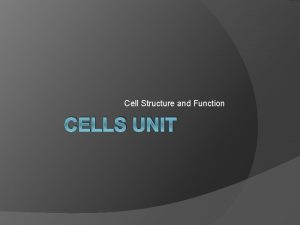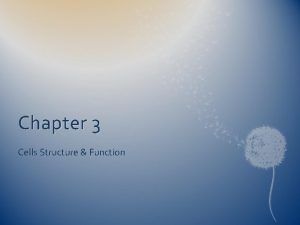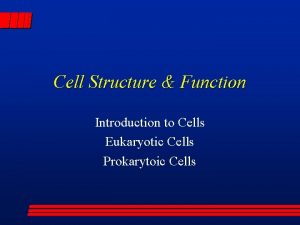Cells Structure and Function Cell Structure Function Cell









- Slides: 9

Cells Structure and Function

Cell Structure & Function Cell Part Function Plant/Animal/ Both? Plant Chloroplast Provides cell with structure & holds it upright Separates the cell from the outside environment Breaks down food molecules for energy to sustain the cell Uses energy from the sun to make food; makes plants appear green Vacuole Stores water and other materials Ribosome Where proteins are made in the cell Digests food particles, wastes and foreign particles Jelly-like fluid which holds the organelles in the cell Contains DNA and is the control center for the cell Cell Wall Cell Membrane Mitochondria Lysosome Cytoplasm Nucleus Both Plant Both (smaller in animal) Both


How do they eat? Euglena Paramecium Amoeba Volvox Autotroph Photosynthesis through eyespot Heterotrophic Using oral groove to pass food through contractile vacuole Heterotrophic Engulfs food by oozing Autotrophic Photosynthesis How do they move? Oozing- cytoplasmic streaming with pseudopods Flagellum Cilia Flagellum asexually and sexually alone colonies How do they reproduce? Do they live alone or in colonies? alone Illustration

Asexual Sexual 1 2 identical Varied Rapid Slow Budding, Regeneration, Binary Fission Animals Starfish, Bacteria, Hydra Humans and animals Number of parents Are offspring genetically identical or varied? Rate of reproduction (fast or slow) Types of each Examples of organisms

Mitosis Meiosis Diploid Haploid 2 identical daughter cells 4 sperm Or 1 egg and 3 polar bodies One Two Type of cell (haploid or diploid) What type of cell(s) does it produce? Number of parent cell(s) Number of cell divisions

The Cell Cycle I. Interphase- The cell grows, makes a copy of his DNA, and prepares to divide into 2 daughter cells II. Cell Division. A. Mitosis 1. Prophase-DNA in the nucleus condenses & becomes visible. The membrane around the nucleus disappears 2. Metaphase- Chromosomes line up in the middle of the cell 3. Anaphase-Chromosomes split and are pulled onto separate sides of the cell 4. Telophase- New nuclear membrane forms around each group of chromosomes. Chromosomes return to their threadlike form B. Cytokinesis- Two new daughter cell form. Each are genetically identical to their parent cell, but smaller

Genetics and Punnett Squares Dominant- describes an allele that determines the phenotype of an individual organism when two different copies are present in the genotype Recessive-describes an allele that is not expressed when combined with a dominant form of the gene Heterozygous- having different pairs of alleles for the same characteristic Homozygous-having identical pairs of alleles for the same characteristic Genotype- the name for the genes an organism has Phenotype-

Example: In rabbits, black fur (B) is dominant to brown fur (b). Give the genotype of a heterozygous black rabbit: _______ Give the phenotype of a homozygous brown rabbit: ______ If a heterozygous black rabbit and a brown rabbit were crossed, what is the probability that their offspring will be brown? Show your work.
 Waters view
Waters view Chlorocruorin
Chlorocruorin Animal cell venn diagram
Animal cell venn diagram Masses of cells form and steal nutrients from healthy cells
Masses of cells form and steal nutrients from healthy cells Muscle tissue parts
Muscle tissue parts Groups of cells that are similar in structure and function
Groups of cells that are similar in structure and function Tissues are groups of similar cells working together to:
Tissues are groups of similar cells working together to: Principal cells vs intercalated cells
Principal cells vs intercalated cells Thyroid parafollicular cells
Thyroid parafollicular cells Gametic cells vs somatic cells
Gametic cells vs somatic cells




